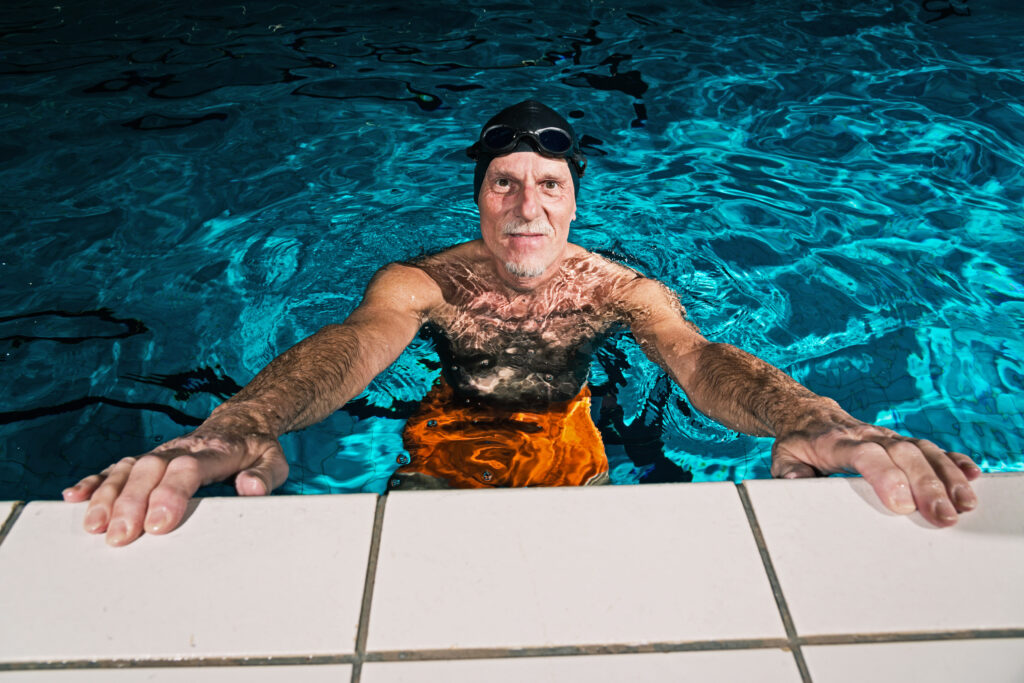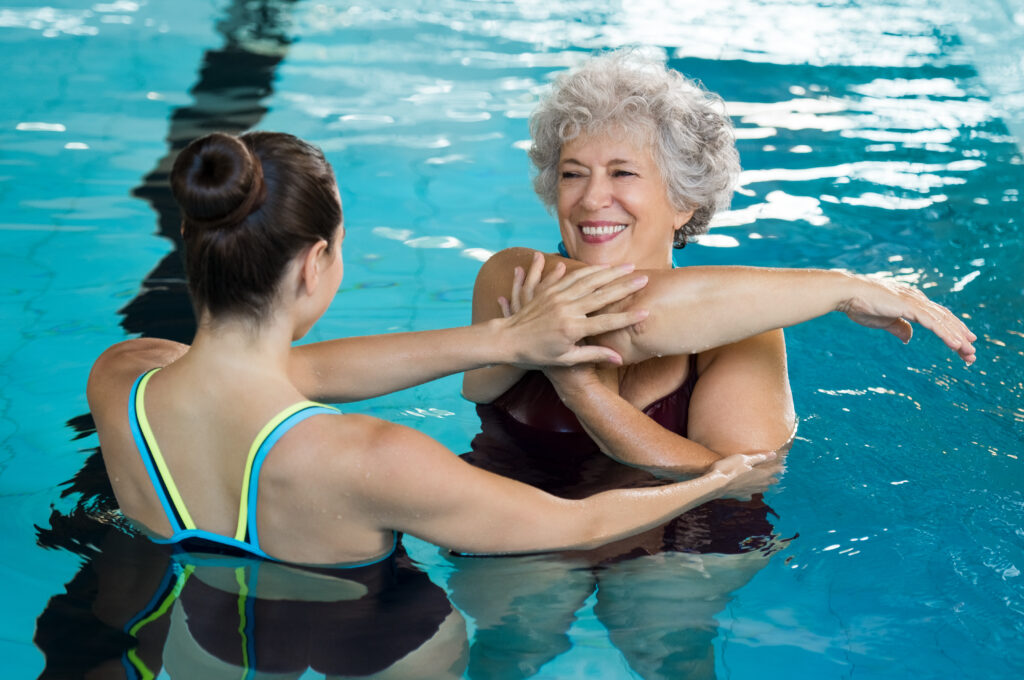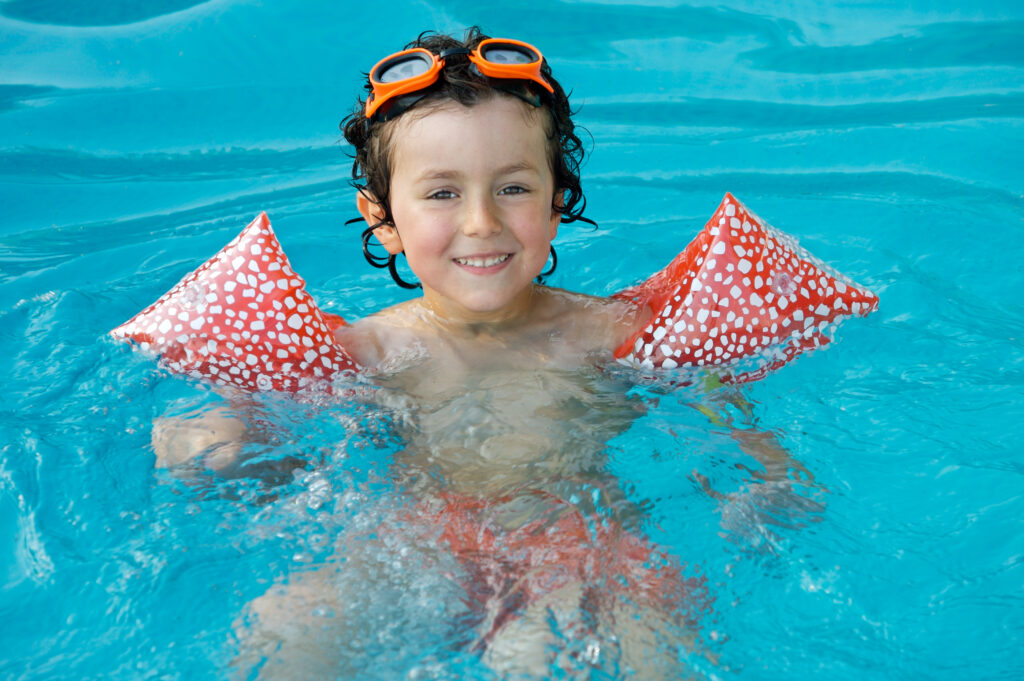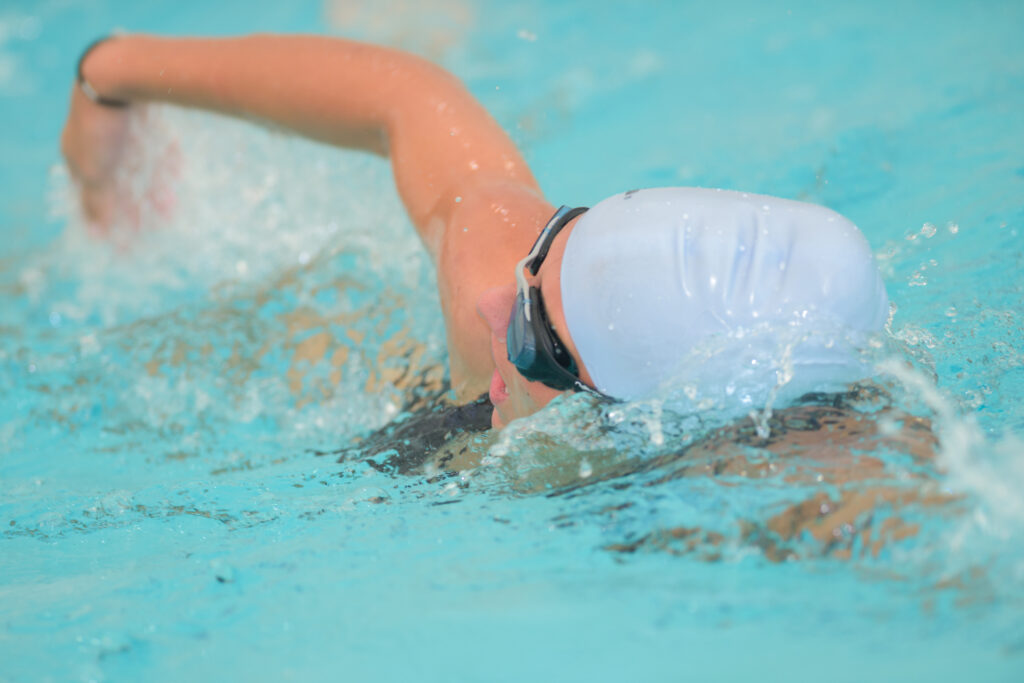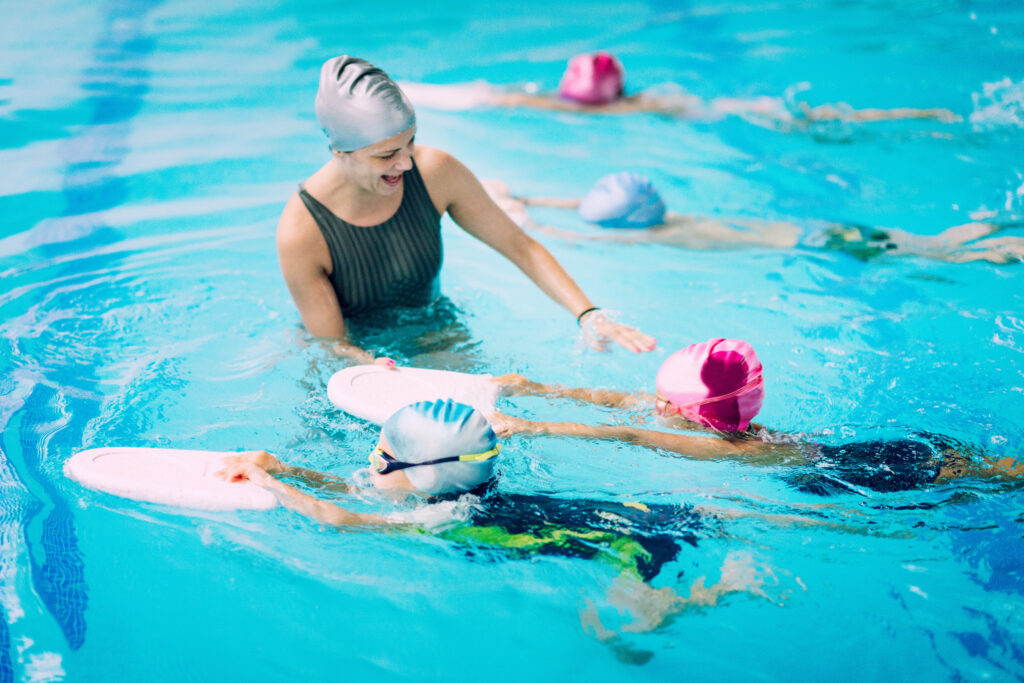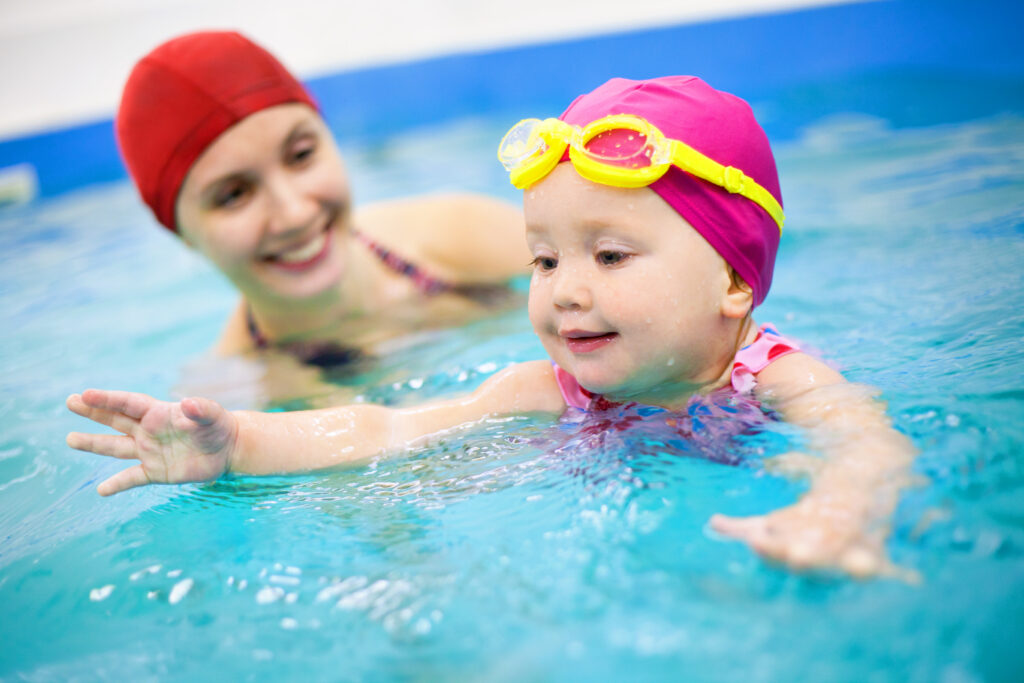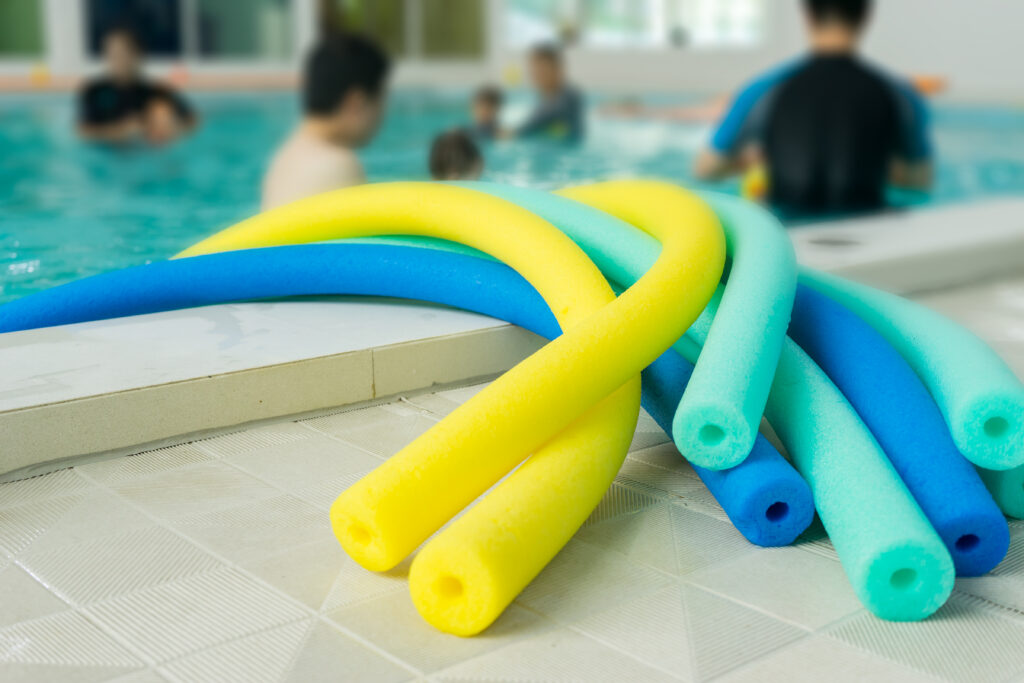Swimming offers a fantastic way to boost fitness and shed extra pounds. As a low-impact activity, it’s gentle on joints whilst providing a full-body workout. Swimming engages nearly every major muscle group, helping to build strength and tone the body from head to toe.
For those looking to lose weight, swimming can be an effective tool. It burns calories, increases heart rate, and builds lean muscle mass. The NHS suggests that regular swimming can help reduce the risk of chronic illnesses like heart disease and type 2 diabetes.
Whether you’re a beginner or an experienced swimmer, there are workouts suitable for all fitness levels. From leisurely laps to intense interval training, swimming can be adapted to meet individual goals and abilities. By incorporating swimming into a balanced fitness routine, many people find it easier to reach and maintain a healthy weight.
The Basics of Swimming for Fitness
Swimming is a fantastic full-body workout that burns calories and builds strength. It’s gentle on joints while providing excellent cardiovascular benefits.
Understanding Swimming as an Exercise
Swimming is a low-impact exercise that works the entire body. It improves cardiovascular health, builds muscle, and boosts endurance. The water’s resistance helps tone muscles and increase flexibility.
Swimming burns calories efficiently. A 70kg person can burn about 500 calories per hour swimming front crawl. This makes it great for weight loss and fitness goals.
The buoyancy of water reduces stress on joints and muscles. This makes swimming ideal for people with injuries or conditions like arthritis.

Swim Strokes for Fitness
Different swim strokes offer varied benefits for fitness. The four main strokes are:
- Freestyle: Burns the most calories and is best for endurance.
- Breaststroke: Works the chest and leg muscles.
- Backstroke: Great for improving posture and working the back muscles.
- Butterfly: Provides an intense full-body workout.
Beginners should start with freestyle or breaststroke. As fitness improves, try incorporating all strokes into workouts.
A basic workout might include swimming one lap of each stroke. Use a kickboard to focus on leg strength, and pull buoys to work on upper body.
Health and Fitness Benefits of Swimming
Swimming offers many health perks. It builds strength and boosts heart health. It’s also easy on the joints.
Cardiovascular and Muscular Advantages
Swimming is great for your heart. It makes your heart and lungs strong. When you swim, your heart rate goes up. This helps your body burn calories and can aid weight loss.
Swimming works your whole body. It builds muscle strength in your arms, legs, and core. The water adds resistance, which helps tone muscles. You can adjust how hard you work by changing your speed.
Low-Impact Workout for Joint Health
Swimming is gentle on your joints. The water supports your body weight. This makes it a top choice for people with joint pain or injuries.
Unlike running or jumping, swimming doesn’t put stress on your knees and hips. It’s a safe way to exercise for people of all ages. Swimming can even help reduce the risk of chronic illnesses like heart disease and diabetes.
Even if you have joint issues, you can still get a good workout in the pool. The low-impact nature of swimming means you can exercise without pain.
Swimming for Weight Management
Swimming is an excellent exercise for managing weight. It burns calories, boosts metabolism, and helps reduce body fat. Many people find it easier to stick with than other forms of exercise.
Calorie Burn and Metabolic Rate
Swimming burns a significant number of calories. A 30-minute swim can use up 200-300 calories, depending on intensity and stroke type. Front crawl tends to burn the most calories.
Swimming also raises your metabolic rate. This means you continue to burn calories even after you’ve left the pool. The effect can last for hours.
Regular swimming can help reduce body fat, including belly fat. This is because it’s a full-body workout that engages multiple muscle groups.
Integrating Swimming into a Weight Loss Routine
To use swimming for weight loss, aim for at least 3-4 sessions per week. Each session should last 30-60 minutes.
Mix up your strokes to work different muscle groups. Try this simple workout:
- 5-minute warm-up: easy freestyle
- 10 minutes: alternate 1 lap fast, 1 lap slow
- 10 minutes: backstroke
- 5-minute cool-down: easy breaststroke
Remember, diet is crucial for weight loss. Swimming can make you hungry, so plan healthy post-swim snacks. Combine swimming with a balanced diet for sustainable weight loss.
Swimming Workout Structures

Swimming workouts can be tailored to suit different fitness levels and goals. They often include interval training to boost calorie burn and improve cardiovascular fitness.
Sample Workouts for Various Fitness Levels
For beginners, start with a 20-minute swim. Warm up with 5 minutes of easy freestyle. Then swim 10 minutes at a moderate pace, focusing on proper form. Cool down with 5 minutes of gentle swimming.
Intermediate swimmers can try a 30-minute workout. Begin with a 5-minute warm-up. Then alternate 1 minute of fast swimming with 1 minute of slow swimming for 20 minutes. Finish with a 5-minute cool-down.
Advanced swimmers might enjoy a 45-minute session. Start with a 10-minute warm-up. Then do 5 sets of 100 metres fast, followed by 30 seconds rest. Next, swim 200 metres at a steady pace. Repeat this pattern 3 times. End with a 5-minute cool-down.
Incorporating Interval Training
Interval training boosts the effectiveness of swimming workouts. It involves alternating between high-intensity bursts and periods of rest or lower intensity.
Try this simple interval set:
- 4 x 50 metres fast with 20 seconds rest between each
- 100 metres easy swimming
- Repeat 3-5 times
For a challenging workout, use a ladder structure:
- 50 metres fast
- 50 metres easy
- 100 metres fast
- 100 metres easy
- 150 metres fast
- 150 metres easy
Interval training helps improve speed, endurance, and calorie burn, making it an excellent addition to any swimming routine.
Additional Health Benefits and Considerations
Swimming offers many health perks beyond fitness and weight loss. It can boost mental health, help with certain medical conditions, and work well with other healthy habits.
Mental and Emotional Well-being
Swimming reduces stress and improves mood. The rhythmic motions and focus on breathing can create a meditative state. This helps calm the mind and lower anxiety.
Being in water also triggers the release of feel-good brain chemicals. These boost happiness and relaxation. Many swimmers report feeling more positive after their sessions.
Regular swimming can even help fight depression. The exercise and social aspects of group swims provide mental health benefits.
Swimming for Specific Health Conditions
Swimming is great for people with certain health issues. It’s low-impact, so it’s easy on joints and muscles.
For those with multiple sclerosis, water’s buoyancy reduces strain. The cool water can also help manage heat sensitivity common in MS.
Swimming can improve insulin sensitivity in people with diabetes. This helps control blood sugar levels.
People with asthma may find swimming easier than other exercises. The humid air around pools can make breathing more comfortable.
Complementary Exercises and Balanced Diet
To get the most from swimming, pair it with other activities. Strength training can boost swimming performance and overall fitness.
Yoga or Pilates can improve flexibility and core strength. This helps with swimming technique and reduces injury risk.
A balanced diet is key for swimmers. Eat:
- Lean proteins for muscle repair
- Complex carbs for energy
- Fruits and veg for vitamins
Staying hydrated is crucial. Drink water before, during, and after swims.
Combining swimming with healthy eating creates a powerful health routine. This approach supports weight loss and overall wellness.
Swimming Gear and Accessories
The right swimming gear can boost your workout’s effectiveness and comfort. Essential items help you get started, while advanced equipment takes your training to the next level.
Essentials for an Effective Swim Routine
A well-fitted swimsuit is crucial for comfort and freedom of movement. Goggles protect your eyes and improve visibility underwater. A swim cap keeps hair out of your face and reduces drag.
For beginners, a kickboard is invaluable. It helps isolate leg muscles and improves kicking technique. Pull buoys, placed between the thighs, focus on upper body strength. Swim fins enhance leg power and improve ankle flexibility.
A waterproof watch helps track time and intervals. Don’t forget a towel and a water bottle to stay hydrated during your swim.
Advanced Equipment for Strength Training
As you progress, consider adding resistance tools to your swim routine. Paddles increase upper body strength by creating more resistance in the water. They come in various sizes to suit different skill levels.
Drag shorts or parachutes provide full-body resistance, intensifying your workout. These tools can help with weight loss by increasing calorie burn.
For dry-land training, resistance bands simulate swimming movements. They strengthen specific muscle groups used in different strokes. A foam roller aids in recovery, helping to prevent muscle soreness after intense sessions.
Safety and Hygiene in Swimming

Swimming is a great way to stay fit, but it’s important to practise safe habits. Always follow pool rules and never swim alone. If you’re new to swimming, consider taking lessons from a qualified instructor.
Before entering the pool, take a shower to remove dirt and oils from your skin. This helps keep the water clean for everyone. Wear a well-fitting swimming costume and goggles to protect your eyes from chlorine.
It’s crucial to stay hydrated while swimming. Even though you’re in water, you can still sweat and lose fluids. Keep a water bottle nearby and drink regularly.
To prevent infections, avoid swallowing pool water. If you have any open cuts or sores, cover them with waterproof plasters before swimming.
After your swim, rinse off in the shower to remove chlorine from your skin and hair. Dry yourself thoroughly, especially between your toes, to prevent fungal infections.
Healthy habits in the pool area include:
- Walking, not running
- Using the toilet before swimming
- Avoiding the pool if you have diarrhoea
- Not sharing towels or other personal items
By following these safety and hygiene tips, you can enjoy a full-body workout in the pool while staying healthy and safe.
Getting Started with Swimming
Swimming is an excellent way to boost fitness and lose weight. It’s easy to start and can be adapted for all skill levels. Here’s how to begin your swimming journey.
Finding the Right Place to Swim
Look for a local pool that suits your needs. Many communities have public pools with lap lanes. Some offer classes for beginners. Leisure centres often have pools with varying depths.
Check the pool’s schedule. Some have designated times for lap swimming or water aerobics. This helps you plan your visits.
Consider the pool’s features. A heated pool can be more comfortable for longer swims. Pools with shallow ends are good for beginners. Some have equipment like kickboards you can use.
Don’t forget outdoor options in warmer months. Lakes and beaches can be great for open-water swimming. Always check safety guidelines before swimming in natural bodies of water.
Setting Achievable Goals
Start with small, realistic goals. Aim to swim for 10-15 minutes without stopping. As you improve, increase your time gradually.
Focus on proper technique rather than speed at first. Good form helps prevent injuries and makes swimming more efficient. Consider taking a few lessons to learn basic strokes.
Set a schedule. Try to swim 2-3 times a week to build consistency. This helps improve your swimming fitness over time.
Track your progress. Keep a log of your swim times and distances. This can be motivating as you see improvements.
Mix up your routine. Try different strokes or add water aerobics to your swim sessions. This keeps things interesting and works different muscle groups.
Frequently Asked Questions
Swimming offers many health perks and can aid weight loss. It’s a great full-body workout for all ages. Let’s dive into some common queries about swimming for fitness.
What are the health advantages of engaging in swimming as a regular form of exercise?
Swimming strengthens your heart and lungs. It boosts cardiovascular fitness and endurance. The water’s resistance helps tone muscles all over your body.
Swimming is gentle on joints. It can improve flexibility and reduce stress. Many people find it relaxing and enjoy better sleep after swimming.
How can swimming contribute to a weight loss regimen and how frequent should one practice?
Swimming burns calories and builds lean muscle. This combo supports weight loss. Aim to swim 3-5 times a week for 30-60 minutes each session.
Mix up strokes to work different muscles. Add intervals of faster swimming to boost calorie burn. Remember, a balanced diet is key for weight loss too.
What kind of swim workouts are best suited for beginners to improve fitness levels?
Beginners can start with simple swim workouts. Try swimming one lap, then use a kickboard for the next. Follow with a lap using a pull buoy.
Repeat this pattern for 15-20 minutes. Gradually increase time and distance as fitness improves. Focus on proper form rather than speed at first.
Can swimming be considered an effective full-body workout, and why is it termed low-impact?
Swimming is indeed a full-body workout. It engages nearly every muscle group. Arms pull, legs kick, and core muscles stabilise your body.
It’s low-impact because water supports your body weight. This reduces stress on joints and bones. You can exercise longer with less risk of injury.
How does incorporating swimming into a fitness routine benefit overall muscle development?
Swimming works muscles throughout your body. The water’s resistance helps build strength and tone. Different strokes target various muscle groups.
Freestyle works arms, shoulders, and back. Breaststroke focuses on chest and legs. Butterfly engages core muscles. Regular swimming leads to balanced muscle development.
Are there any notable differences in the effectiveness of swimming for fitness among various age groups?
Swimming benefits people of all ages. For children, it aids physical development and coordination. Teens and adults can use it for fitness and weight management.
Older adults often find swimming gentler on joints than other exercises. It helps maintain mobility and strength. Swimming can be adapted to suit any fitness level or age group.

